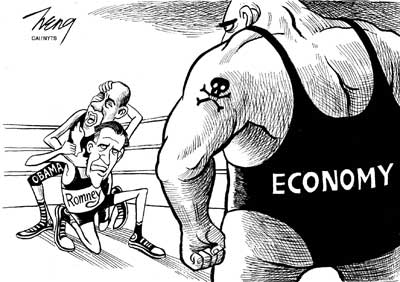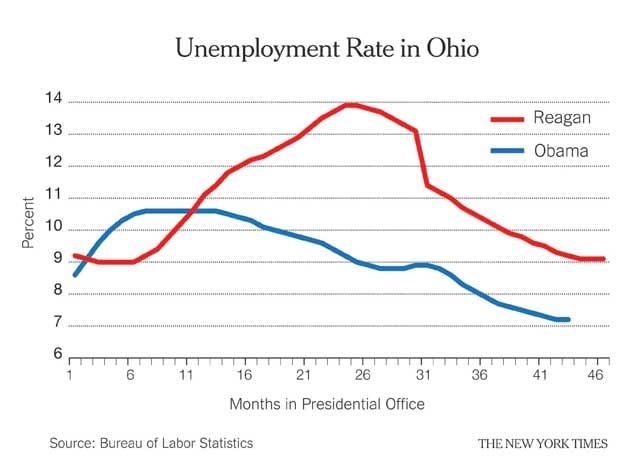
One thing we keep hearing from political pundits is that the state of the economy should lead to a crushing defeat for President Obama — no president has ever been re-elected with unemployment this high, etc.
But as quite a few better-informed people have pointed out, the political science literature is unambiguous on this point: What matters isn’t the state of the economy, it’s the perception of trend. If the economy appears to be improving, the incumbent tends to do well even if in absolute terms it’s still pretty bad.
By that standard, Mr. Obama is in a much better position than the conventional wisdom would suggest: the economy isn’t booming, but it’s growing, and the labor market is moving sideways rather than down. It’s not President Reagan’s “Morning in America” (which reflects the different and much more intractable nature of the 2008 crisis and aftermath), but it’s not the political disaster you might imagine.
But wait, there’s more: Elections aren’t decided by national popular vote, but state by state. And it seems likely that this election will be decided in the industrial Midwest, Ohio in particular — a region that has bounced back strongly.
Here’s a comparison I haven’t seen elsewhere: the unemployment rate in Ohio under two administrations, on the chart on this page.

Unemployment was still very high in Ohio when Ronald Reagan was campaigning for re-election. But it was coming down, and most people blamed the previous administration for the surge in unemployment that had occurred before.
And you could say exactly the same thing this time around, with the added twist that much of the good news can be attributed to the auto bailout that Mr. Obama carried out in the face of frantic G.O.P. opposition.
Now, national sentiment matters too, and Mr. Obama obviously can’t run a campaign on boosterism. But the key point is that the economic background isn’t that bad for him politically; it’s good enough, in particular, for him to try to turn this into a “choice” election that his opponent clearly isn’t ready for.
Inflation Expectations: A Feature, Not a Bug
And now for something completely different: I’m a bit puzzled by the tone of a recent article in the Financial Times on how the Federal Reserve’s new policy is doing so far. The headline is “U.S. Inflation Fears Rise After QE3,” and the writer seems to imply that a rise in breakeven rates — the difference between the interest rate on ordinary bonds and inflation-protected bonds — is a danger sign. (Breakeven rates are a simple gauge of expected inflation).
On the contrary, it’s the whole point of the exercise. For almost 15 years, some of us have argued that central banks can gain traction even in a liquidity trap if they can create expectations that money will remain loose after the economy recovers, generating modestly higher inflation. And that’s what the Fed’s new tack is supposed to achieve.
The right headline on that article should have been “QE3 Working So Far.”
We’re not backing down in the face of Trump’s threats.
As Donald Trump is inaugurated a second time, independent media organizations are faced with urgent mandates: Tell the truth more loudly than ever before. Do that work even as our standard modes of distribution (such as social media platforms) are being manipulated and curtailed by forces of fascist repression and ruthless capitalism. Do that work even as journalism and journalists face targeted attacks, including from the government itself. And do that work in community, never forgetting that we’re not shouting into a faceless void – we’re reaching out to real people amid a life-threatening political climate.
Our task is formidable, and it requires us to ground ourselves in our principles, remind ourselves of our utility, dig in and commit.
As a dizzying number of corporate news organizations – either through need or greed – rush to implement new ways to further monetize their content, and others acquiesce to Trump’s wishes, now is a time for movement media-makers to double down on community-first models.
At Truthout, we are reaffirming our commitments on this front: We won’t run ads or have a paywall because we believe that everyone should have access to information, and that access should exist without barriers and free of distractions from craven corporate interests. We recognize the implications for democracy when information-seekers click a link only to find the article trapped behind a paywall or buried on a page with dozens of invasive ads. The laws of capitalism dictate an unending increase in monetization, and much of the media simply follows those laws. Truthout and many of our peers are dedicating ourselves to following other paths – a commitment which feels vital in a moment when corporations are evermore overtly embedded in government.
Over 80 percent of Truthout‘s funding comes from small individual donations from our community of readers, and the remaining 20 percent comes from a handful of social justice-oriented foundations. Over a third of our total budget is supported by recurring monthly donors, many of whom give because they want to help us keep Truthout barrier-free for everyone.
You can help by giving today. Whether you can make a small monthly donation or a larger gift, Truthout only works with your support.